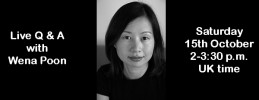
photo by Kriss Szkurlatowski
by Mike Smith
Reading other writers on writing is one thing. Reading theorists is another. I’ve recently been reading Susan Lohafer’s essay ‘A Cognitive Approach to Storyness’ in The New Short Story Theories (ed. Charles E. May, Ohio, 1994) and have found a few nuggets of advice which may be useful for writers as well as for academics.
On the quest to define the short story in terms of what it does and what it is (her italics), and thus to explain something about why we are so prone to engagement with it, both as readers and writers, Dr. Lohafer creates and interprets a fascinating set of data. Introducing the idea that stories have ‘anterior’ and ‘penultimate’ as well as ‘final’ closures, she throws a new light on the issue of endings.
What she is suggesting is that if we look closely at short stories we will find two places – in effect, two sentences – where we perceive that the story might have ended before it actually does. The anterior closure lies nearer to the beginning of the story, the penultimate nearer to the end, and the final closure comes of course with the very last sentence. This is an enjoyable academic game to play, and she plays it thoroughly, selecting stories written during the years 1820-1980. She splits this into three periods, ‘Early’, ‘Modern’, and ‘Contemporary’, with the middle period running from 1920-1940. She then looks for her premature closures and, having identified them, proceeds to analyse them through the filter of various qualities that they might be seen to possess. Examples include whether or not the closure sentences have inverted verb-subject orders, forms of replication, or whether they are alliterative. From these analyses she was able to produce a series of statistical relationships between the three periods: 17:1:12, for instance, is the ratio of alliterative closural sentences.
Of course, the salamander in the woodpile is that almost all of this is purely subjective. How little alliteration, for example, renders a sentence alliterative? Would another reader identify the same sentences in the first place? Dr Lohafer, however, is no fool. She recognises that she was ‘making explicit her own sense of storyness’, which is something that any of us might benefit from doing, especially the writers among us.
There is also an issue to examine around what these putative ‘anterior’ and ‘penultimate’ closures actually are. Do they represent an imposition by the reader, or were they put there by the writer? Are they evidence of some lapse of control or loss of vision in the writer’s case? Do they imply a ‘bolting-on’ of an appendage? A confession here: I once wrote a story aimed at a particular magazine that looked for 4,000-word stories. My story was too short, so to make it more acceptable, I bunged (yes, that’s the word) another thousand words on the end. Pure waffle, reflection and authorial comment. It wasn’t accepted, but it did go on to win a prize of a couple of hundred quid, which is arguably (undoubtedly?) more useful than the vanity-boosting magazine publication would have been! I have also encountered, in a colleague’s work, a short story deemed unfinished, to which a second chunk (sorry about all this technical jargon) had been added, and a third was proposed. Would these actual premature endings show up, I wonder, as Dr Lohafer’s anterior and penultimate closures?
Another possibility is that premature closures are an inherent part of the structure of stories: one of the legs of the tripod, planks of the raft, whichever metaphor we choose. Might they be elements that have to be in place for the final closure to work? Do they occur naturally, even if the writer has not planned them? If so, will we benefit, as writers, from an awareness that they exist?
In the same collection of essays, B. M. Ejxenbaum (O Henry and the Theory of the Short Story) uses the metaphor of the falling bomb to support his contention that the short story ‘amasses its whole weight towards the ending’ (his italics). This has become my assumption about the form, and hasn’t been shaken by stumbling upon any earlier closure sentences in the stories I have read; but then, I have not been looking for them.
Literary theorising is not the same as reading, nor as writing, but it may throw a useful light on those activities. Sometimes it goes beyond what is obviously practical (‘…these features suggest a general shift to paratactic as opposed to hypotactic structures’ – Lohafer), but there are nuggets of useful common sense (‘We must therefore look at the closure sentences in relation to the stories they terminate’ – Lohafer).
Here’s a game, then, that we might play, looking to our own and others’ stories, and a study that is certainly worth reading. The fact that the cognitive theorist is working towards an understanding of why, as readers and writers, we are so compelled to engage with a story, does not preclude us from finding within their work, some clues as to how we might read a story, or how we might write one.


I have a terrible time with endings too. Some are inevitable and a writer can see those coming but most give me trouble. This is when intuition and just plain bravery on the part of the writer – for this writer at least – comes in. I have a lot to learn, that’s for sure, but your articles definitely makes me take a closer look at endings and hopefully help me to fine-tune them.
Interesting, Mike. I’m sure most writers aim for the ‘falling bomb’ approach – the idea that the story gathers momentum and ends with an explosion. The explosion can be very quiet, of course. But endings are so difficult. I remember when I was workshopping short stories with my MA group, there were several occasions when members of the group assumed they had read only the first instalment of a short story, when in fact they’d been presented with the whole thing, or vice versa – they thought it was a great ending, only to be told there was more to come. Eventually we agreed to write ‘THE END’, when appropriate, to avoid confusion!